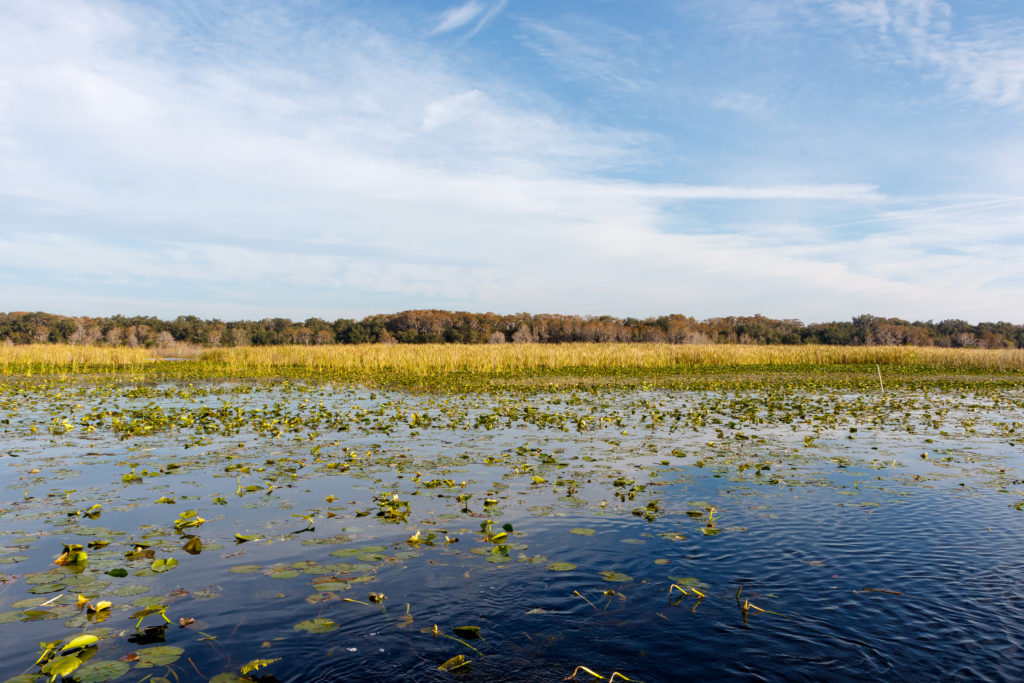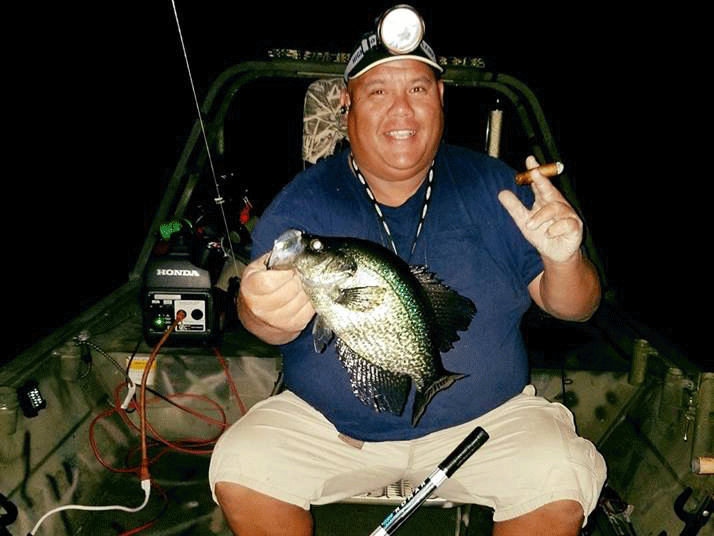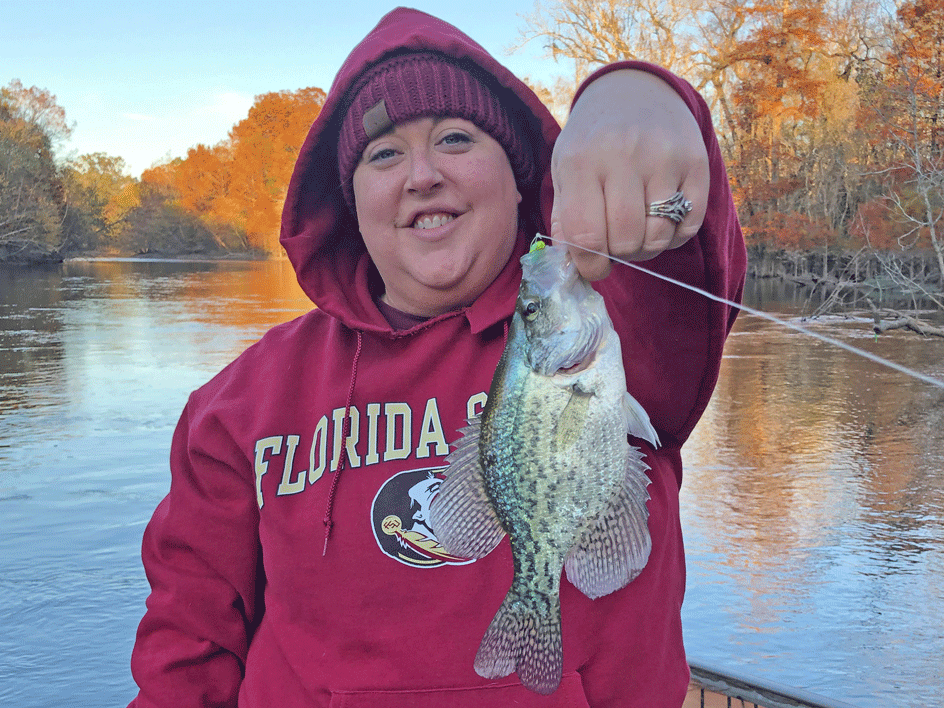The Sunshine State isn’t only about world-class saltwater fishing opportunities. It’s also home to a network of lakes and rivers filled with delicious fish. One of those is Crappie, locally known as “Speckled Perch,” a favorite across the US. If you’re a freshwater enthusiast, Crappie fishing in Florida is definitely a must.
What’s so special about Speckled Perch fishing? First of all, they’re not at all hard to catch. Finding them is the challenging part, requiring the most knowledge and experience. However, Crappie fishing is fun for the whole family; even seasoned anglers enjoy catching them. In fact, both local and visiting anglers come to Florida every year to fill their bucket with these delicious fish.

In this guide, we’ll talk about the large and healthy populations of Florida Crappie. We’ll cover the top spots, techniques, and seasonality. On that note, let’s get started.
When to go Crappie fishing in Florida?
The best part about Speckled Perch fishing in Florida is that it’s year-round. However, these fish tend to bite better during certain times of the year. November through March is considered the peak season, boosting the number of potential catches.
Thanks to Florida’s mild winters, the pre-spawning period of Crappie lasts a little longer here. If you’re hitting the waters during the colder months, feel free to target the fish right in the shallows of lakes and rivers. In general, though, you can find Speckled Perch at every depth of water. Outside the spawning season, they hang out offshore, where they feed on crustaceans and small insects.

How much time do you need to fish for Crappie? The short answer is, anywhere from two to eight hours. Crappie addicts can get their fix in the first couple of hours and head back, while anglers with kids can stay much longer.
Some guides offer night fishing for Crappie, which is a year-round pleasure. Most locals say that early morning and late afternoon are more productive during the winter and spring months.
Where to go Crappie fishing in Florida?

If we were to describe every Specks fishery in the Sunshine State, we’d need a separate article. There are so many chained lakes and waterways throughout Florida that are full of Crappie.
From Lake Okeechobee and the Ocala National Park in Central Florida to the creeks out of Seminole in the West, there’s a spot for any angler. In fact, you can find Crappie even around the coast! Work your way down St. John’s River, and check the northern Everglades or even Fort Lauderdale.
In this section, we’ll talk about our favorite spots for Crappie fishing in Florida. Let’s start with one of the most famous Crappie lakes…
Lake Kissimmee

You got it right, Lake Kissimmee isn’t just about Bass fishing. Crappie haven’t always been among the most popular catches here, though, but things changed not long time ago.
The lake is actually pretty shallow, with an average depth of just 5 feet. It’s not a small lake, though, spanning over 35,000 acres. Specks fishing on Lake Kissimmee usually happens along the grass line, in deeper holes, and offshore. A lot of anglers brag about big catches, so a 14” catch is not uncommon.
Since Lake Kissimmee is mostly a Bass fishery, you can pack your heavier fishing gear and target those, too.
Lake Okeechobee

You can’t go wrong with Lake Okeechobee. Locals often refer to it as the “Inland Sea,” covering 730 square miles. As the largest lake in Florida, Okeechobee offers excellent fishing opportunities, and Crappie is among the potential catches there.
Just like Lake Kissimmee, Lake O is pretty shallow for a body of water of its size. The average depth here is just 9 feet, making it a perfect place to target Specks. There’s plenty of vegetation where you could look for a school of Crappie. And, of course, you can mix it up with a bit of Bass fishing, too!
Lake Toho

Crappie fishing on Lake Toho is among the most popular activities in Central Florida. These fish are in great abundance here, so filling your limit isn’t hard. Some Crappie guides concentrate on West Lake Toho, which is located south of the city of Kissimmee, although you can find Specks throughout the lake.
Locals report “big catches” of over 14 inches in length pretty often. If you’re fishing with a local guide, you might increase your chances of catching Crappie at over 2 pounds. A knowledgeable guide can help you fill the bucket much faster.
The beautiful Lake Toho is also a popular Bass fishery, so you can combine Specks fishing with targeting Largemouth.
Lake Istokpoga

Lake Istokpoga is another acclaimed Bass fishery, though it’s also a perfect spot for a winter Crappie fishing trip. The lake covers around 28,000 acres, allowing you to explore miles of excellent fishing grounds.
During warmer months, anglers on Lake Istokpoga look for Crappie around bulrush and spatterdock along the shoreline. This is where they move to spawn as the water temperature hits around 65 degrees. As usual, you might have more luck looking for Specks in areas with vegetation and 3–6 feet of water.
It comes as no surprise that Lake Istokpoga is a good place for a mixed-bag trip. You can take your heavier gear and target Bass, Bluegill, and even Catfish once you’re done with Crappie.
And More!

While the Istokopa, Toho, Okeechobee, and Kissimmee lakes are prime Crappie spots in Florida, there are plenty of other lakes throughout the state. Here’s a list of other spots you might want to consider for a Crappie fishing trip:
- Lake Jessup. This 10,000-acre lake is located south of Sanford. Anglers prefer to drift in the middle of the lake or right by Bird Islands and Soldier Creek. Crappie here don’t grow too big, but you can definitely come to fill your bucket.
- Lake Monroe. North from Lake Jessup, you’ll find Lake Monroe, which is similar in size. Impressive catches are common here, especially after the FWC’s habitat restoration efforts.
- Orange Lake. When fishing Orange Lake, anglers often combine it with the neighboring Lochloosa Lake. Both are located between Gainesville and Ocala and offer great Specks fishing opportunities. The spring spawning season is perhaps the best time to fish these lakes.
- Lake Talquin. This 8,800-acre reservoir is located west of Tallahassee. A lot of Crappie enthusiasts pay this lake a visit when they’re looking for bigger catches. There’s a 10-inch minimum size limit, and Lake Talquin has seen some pretty impressive catches.
- Tenoroc. This is a 7,300-acre Fish Management Area right near Lakeland that includes various lakes. Crappie anglers especially enjoy the winter season with plenty of productive areas to dunk a bobber. Note that some of the lakes are open to fishing a couple of days a week.
- Lake Weir. Lake Weir is a 5,695-acre body of water located in South Marion County. What makes it unique is the atypical depths, with some exceeding 20 feet. The FWC refurbished Lake Weir and added 12 brush fish attractors, which you can spot through the lake.
- Winter Haven Chain of Lakes. Finally, you can enjoy a great Specks fishing experience in this famous chain of lakes in Winter Haven. There are dozens of smaller lakes at your disposal very close to the city itself.
How to go fishing for Crappie in Florida?

The success of your Crappie fishing adventure depends on several factors. For example, during warmer months, Specks hang out around deeper underwater structures, so you might need to rely on fish finders. Additionally, locating the proper depth is especially important. Crappie can be a foot from the surface one day, and a foot from the bottom the next.
You can use several rods and poles and check different depths until you’ve found the suitable concentration of Crappie. As for the technique, some Specks anglers go for drifting or slow-trolling in open water.
Finally, when it comes to bait, there are various types of live bait and artificial lures you can use to get the fish to bite. It varies from live bait to jigs, spinners, and more.
As a favorite sport fish throughout Florida, Specks are a perfect target on shorter trips. Keep in mind that there’s a daily bag limit of 25 fish.
Crappie Fishing in Florida FAQs

Do I need a fishing license?
- All anglers aged 16 and over need to have a valid Florida license to fish for Crappie. You can get your permit online, by phone, or at a licensed retailer across the state.
How long does a fishing trip for Crappie last?
- Typical Crappie fishing trips last anywhere from two to eight hours. The duration of your trip depends on how quickly you fill the daily limit and whether you want to fish for a mixed bag.
Can I keep the catch?
- Sure! The bag limit for Crappie is 25 fish per person per day. The possession limit is two days’ bag limit per licensed angler.
Is Crappie fishing kids-friendly?
- Fishing for Crappie is especially great for kids. They’re fun and easy to catch. There’s hardly a better way to introduce your younger anglers to freshwater fishing!
What’s the biggest Crappie ever caught in Florida?
- According to the FWC website, the state’s record Crappie was caught on Lake Talquin in 1992. It was a 3.83 lb Crappie, which is pretty impressive!
Crappie Fishing in Florida – Easy and Fun for Everyone!

There’s such a wealth of Crappie fishing in Florida when it comes to lakes, that you’re practically spoiled for choice. With just a vote of confidence, anyone can do it. If you want to make the most out of your Specks adventure, book a trip with a local guide. Crappie fishing in Florida is like its own religion for local anglers. Don’t take our word for it, though. See it yourself!
Have you ever fished for Crappie in Florida? Where did you go? What’s your favorite Specks fishery? Let us know in the comments below!
The post Crappie Fishing in Florida: The Complete Guide appeared first on FishingBooker Blog.
https://ift.tt/PQtFpHe
0 Comments
Enregistrer un commentaire